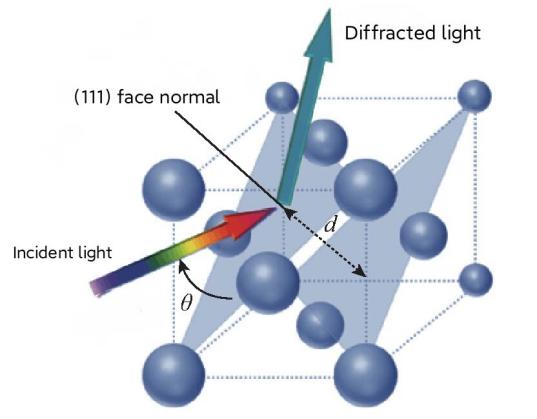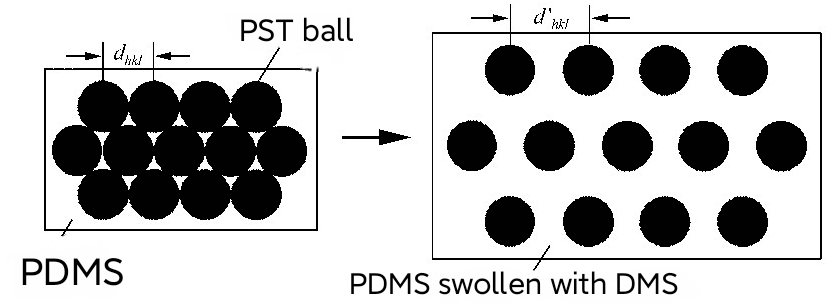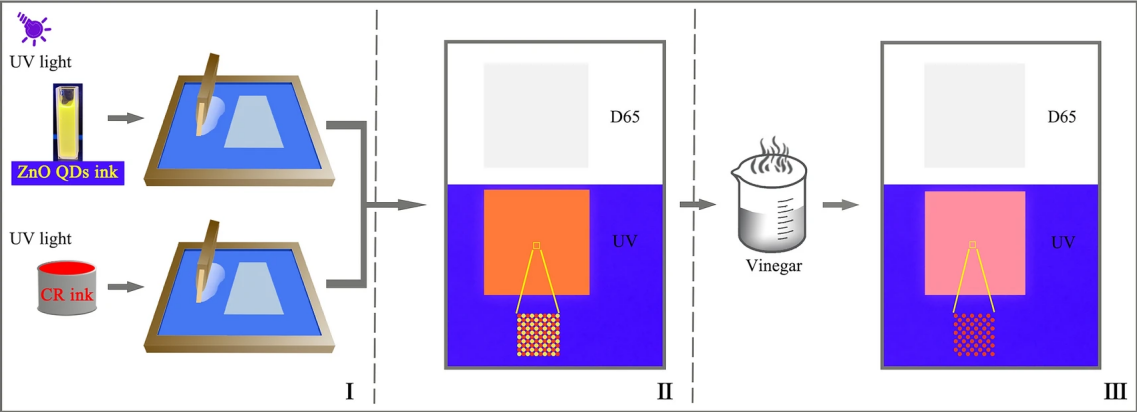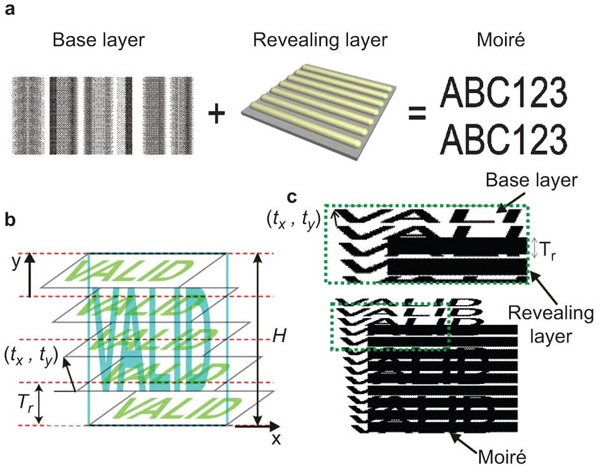1. Introduction:
Photonic Crystals(PCs) was independently proposed by E. Yablonovitch,they are artificial microstructures formed by periodic arrangement of media with different refractive index,it has crucial applications in optical integrated circuits[1]. Photonic crystals materials are generally composed of two materials with different refractive index, one of which is periodically distributed in the other[2]. According to the structure of photonic crystal, it has a seasonal dielectric structure on the optical scale that makes it has the function of wavelength selection, which can selectively make light of one wavelength pass through and prevent light of other wavelengths from propagating[1]. When the frequency of visible light belongs to the scope of PBG, PCs indicate a vivid rainbow reflection hue, which is a well-known structural color[3]. Photonic crystals show great potential in anti-counterfeiting materials owing to their unmatched photonic band gap characteristics and tunable physical color[4]. When PCs is applied to making anti-counterfeiting material, its jarless rainbow structure hue cannot be simulated by dyes, and pigments are incompetent to imitate it either[5]. In addition, their glamorous reflection spectra are also invaluable for the domain of anti-counterfeiting[6]. As a consequence, in recent years, PCs based anti-counterfeiting substances have allured comprehensive attention.
Various approaches has been used to prepare PCs, such as soft-crystal polymerization of lanthanide complexes[7], sub-cellular resolution[8], and mechanical drilling[9]. These micro-fabricated approaches will get PCs with accurate structures, however, they are complex and will consume a lot of time. Moreover, the work to actualize the band gap in the visible band for the 3-D optical elements produced by these recipes is stiff to a certain extent[10]. Therefore, a fungible method to surmount these limitations called converting colloidal nanoparticles to ordered colloidal PC structures by self-assembly, was investigated. Spray coating, spin-coating ,electrodepositionand inkjet printing are common self-assembly methods[11-16], these are handy and inexpensive invariably[17]. Furthermore, external stimuli is able to modulate the band gap and physical color of colloidal crystallines.For instance, steam [18], temperature[19], electric field[20] and magnetic field[21] can all regulate them, whose effects are simple to be distinguished by spectrograph, even by naked eyes. Compared with micromachining computer, colloidal computer is an ideal choice for anti-counterfeiting material because of its advantages such as simple sample preparation, adjustable optical performance and flexible geometric structure.
Based on the tunable structural colour, the anti-counterfeiting colloidal photonic crystal materials can be grouped to two descriptions: visible colloidal PC patterns and invisible colloidal PC patterns. In this review, the property and working principles of colloidal PC patterns will be introduced. Then show several approaches of making photonic anti-counterfeiting banknotes.Then analyze the advantages and drawbacks of colloidal PC patterns. Finally,I will sum up the challenges the anti-counterfeiting colloidal PC materials are facing and the occasions they possess.
2. Mainbody
2.1. Property and working principles of colloidal PC patterns
Photonic crystalloids are periodic arrays of materials whose dielectric constants are various.The most fundamental characteristic of the long-range ordered structure is that it has a photonic band gap.Therefore, photonic band gap materials is another name of photonic crystalloid. In the light of the substance, the periodic arrangement of materials can classify photonic crystalloid into 1,2,3-dimensional structure[22]. Generally,the colloidal microspheres experience diffusion, rearrangement, stacking and other steps in the controllable self-assembly procedure.
The resulting assembly is called colloidal photonic crystal, which is an important template material for photonic crystal related research. The photonic band gap of such colloidal photonic crystals also obeys Bragg's law, that is, the Bragg equationits dictates its diffraction wavelength:
m∗λ=2∗na∗d∗sinθ
In this equation, m is called the diffraction order,λ represents for the diffraction wavelength and d is addressed as crystal plane spacing, na means the effective refractive index and θis the angle of incidence. Owing to the three-dimensional ordered periodic structure of colloidal crystals, like X-rays’ Bragg diffraction in atomic, ionic and molecular crystallines, visible light (400-700nm) can also generate Bragg diffraction in colloidal crystals formed by micron and submicron monodisperse particles.Thereby rendering these materials different colors.This hue,which is not caused by pigment, but due to light scattering, diffraction, or interference with the microstructure of the material is addressed as structure color.From the diffraction pattern shown in Fig. 1, it is obvious that the hue of colloidal crystals (corresponding to the wavelength of visible light that relates to Bragg's law) will vary with the crystal planes spacing d as long as the incident light angleθis fixed. Using this property, colloidal crystallines is capable of being applied to sensors, photonic paper (anti-counterfeiting banknotes) and other functional devices or materials.

Figure 1. Illustration of Bragg diffraction from collidal photonic crystal
2.2 Several approaches of making photonic cystal anti-counterfeiting banknotes
The difficulty of making photonic crystals lies in making sufficiently small lattice structures of different dielectric materials. The size and array spacing of the lattice elements must be the same order of magnitude as the wavelength of the light for the sake of controlling the light more effectively.Colloidal crystals have unique advantages in the preparation of photonic crystals: Firstly, colloidal crystalloids are three-dimensional (The following will be referred to as 3-D for short) lattices of two media in space (colloidal particles and the air between them) . It is very convenient to adjust the lattice units and arrangement spacing, which can be achieved only by adjusting the particle size. Secondly, the porous material prepared by using colloidal crystal as template is a reverse (or reverse) copy of the 3-D ordered structure of colloidal crystal, the resulting pore structure is a 3-D lattice located between two media (pore wall and pore material) . If we want to adjust the hole-wall material’s dielectric constant, or the pore size of these prepared material, we only need to modify the material type filled in the template of colloidal crystalline and the particle size of the monodisperse particles that form the colloidal crystal, this can avoid many troublesome procedures. Last but not least, the gap between colloidal crystal particles or the prepared porous materials can be filled with other dielectric materials to improve the difference in dielectric constant between colloidal particles or pore wall materials and the filled materials, so as to form photonic crystals with wide band gap, controllable band gap and complete band gap[23]. Several methods of making photonic anti-counterfeiting crystals will be exemplified below.
2.2.1 Photonic paper for color writing with colorless solvent
Fudouzi et al. reported that methyl silicone rubber (PDMS) embedded in PST colloidal crystal was swelled by solvent (such as dimethylsiloxane DMS) to change the crystal plane spacing and color of colloidal crystal, thus developing the research on photonic paper for color writing with colorless solvent. It also provides a feasible method for manufacturing photonic crystal anti-counterfeit banknotes.The working principle of photon paper is shown in Fig. 2[24].

Figure. 2 Illustration of photonic paper making from colloidal crystals
2.2.2. Flourescent anti-counterfeiting ink technology
A large number of special inks are used in banknote printing to prevent counterfeiting.Flourescent anti-counterfeiting printing ink is a crucial part of anti-fake techniques, and it has been extensively applied thanks to its low tariff, lekker concealment, and can easily identificated. Traditional fluorescent ink is often surrogated by three primary hue organic fluorescent ink, which has a vast utilization in banknotes. However, the quality of ink may become worse because of their limited inclusiveness[25]. Consequently, the manufacture of a bright fluorescent and high-quality function of anti-counterfeiting ink is also an urgent requirement.
The combination of ZnO quantum dot fluorescent ink and organic fluorescent ink could strengthen the utility of fluorescent ink more so as to fight against fake. As shown in Fig3 i, the printing plate had a screen score of 200 lpi and a half tone value of 50%. Overprinting was performed using CR ink and ZnO quantum dot fluorescent ink. The overprinting effect of the hue block invisible under the orange red fluorescence under D65 light and ultraviolet irradiation was revealed in Fig3 ii. Moreover, the local magnified graphic simulated the permutation of two fluorescent ink dots. The fluorescent effect of diverse hues could be attained as long as the dot percentage of the ink was modified, then we would acquire preferable anti-counterfeiting effect. On the basis of the fluorescence quenching of ZnO quantum dots, the hue spots were treated with vinegar in Fig3 iii. The hue spots did not mutate under D65 light, it only emitted red fluorescence from Cr ink under UV irradiation, which means that the yellow fluorescence of the self-produced quantum dot fluorescent ink was annihilated. The security of anti-fake method was enhanced deeper by this action[26].

Figure 3.The flow chart of the fluorescent discoloration anti-counterfeiting approach.
2.2.3 A microfabricated 1D moiré enabling complex high-resolution patterns
When two various periodic structures overlap, the resulting interference pattern is called moiré . It is a very interesting anti-counterfeiting protection mechanism because it creates images that are exceedingly sensitive to small changes in the primitive layer.In a one-dimensional moiré configuration, design elements such as text, graphs, grayscale, and color patterns can be arranged freely along the length of the baseband[27]. When the moiré period is a determinate value, the number of elements that can be merged is positively correlated with the length of the baseband. Hence, one-dimensional moiré can produce numerous features consisting of dozens of letters or symbols that can be moved along a straight line when one layer is dislocated relative to the other[28].
The linear one-dimensional moire fringe is formed by superimposing the linear base layer and the linear display layer, as shown in Figure4 a. For each desired moire shape, pairs of base layers and exposed layers with different layouts but matching can be used to prevent the moiré from direct reproducting. Figure4 b unveils an ensample of the nexus between the strips of the base layer, which includes green inclined "VALID" element, the lucent display layer is surrogated by a red dotted sample line, and the consequential moiré shape element "VALID" is surrogated by a cyan pattern.1D moiré fringes are shown in Fig4 c at a scale of 1:1. Seasonal strips, including perpendicularly flattened text "VALID" as the base layer, are superposed with display line gratings with cloudy and lucent cross portions. In the area where the display line gratings overlap, moiré fringes formed by the corresponding enlarged text can be seen, and the period of the baseband copy vector (tx, ty) and the display layer line grating (tr) are unveiled[29] in the amplified portion.

Figure 4. Linear 1D moirés
2.3 Advantages and disadvantages of colloidal PC patterns
In recent years, the anti-counterfeiting technology of patterned colloidal photonic crystalloids has achieved rapid development. Because of its reusable, non easy to copy and easy to identify characteristics, it has shown great potential in anti-counterfeiting technology. However, there are some problems in the preparation of colloidal photonic crystal patterns mentioned above or in the application of anti-counterfeiting marks. For example, it is still a challenge to realize stable periodic structure, uniform response characteristics, relatively low production cost and mass production; The convenience of anti-counterfeiting pattern detection and the role of anti-counterfeiting pattern are too single, which needs to be optimized and improved.
3. Conclusion
Colloidal PCs offer a brand new avenue to design anti-counterfeiting banknotes.Combined with the development tendency of technique against fake, dynamic anti-counterfeiting and multi-dimensional information anti-counterfeiting technique can improve the hard copy of anti-fake information, and are two anti-counterfeiting means with more development potential.For example, there is a method to build a 4D screening anti-fake micro design by printing layer by layer[30], this pattern can display four various graphics according to diverse lighting ambient, and it is also capable of being designed into a two-dimensional code, which integrates anti-counterfeiting and information storage.However, when using the smartphones to identify the two-dimensional code to acquire messages, whether the anti-counterfeiting pattern will disturb the information reading or damage the information content needs further experimental investigation. The further development of patterned colloidal photonic crystals will bring a variety of new anti-counterfeiting markers with outstanding functions and wide applications.
Nevertheless, an advanced anti-counterfeiting material with fast deciphering, stellar hiding and display effects, as well as high durability, has not been actualized in reality so far. Several challenges of PC based anti-counterfeiting materials go beyond the photonic crystalline itself. The case in point is that invisible photon printing of electric field display has swift and impactful hiding and display effects, but its rigid and brittle conductive substrate limits its further application on delicate target surface. Accordingly, implementating new flexible electrodes instead of FTO, like conductive polymer electrodes, will widen its application ranges[31].
References
[1]. Yablonovitch, E. Photonic band-gap structures. J. Opt. Soc. Am. B 1993, 10, 283–295.
[2]. Xiong, L., Forsythe, C., Jung, M. et al. Photonic crystal for graphene plasmons. Nat Commun 10, 4780 (2019). https://doi.org/10.1038/s41467-019-12778-2
[3]. Hou, J.; Li, M.Z.; Song, Y.L. Recent advances in colloidal photonic crystal sensors: materials, structures and analysis methods. Nano Today 2018, 22, 132–144.
[4]. Lee, H.S.; Shim, T.S.; Hwang, H.; Yang, S.-M.; Kim, S.-H. Colloidal photonic crystals toward structural color palettes for security materials. Chem. Mater. 2013, 25, 2684–2690.
[5]. Hu, H.; Chen, Q.-W.; Tang, J.; Hu, X.-Y.; Zhou, X.-H. Photonic anti-counterfeiting using structural colors derived from magnetic-responsive photonic crystals with double photonic bandgap heterostructures. J. Mater. Chem. 2012, 22, 11048–11053.
[6]. Yang, D.; Qin, Y.; Ye, S.; Ge, J. Polymerization-induced colloidal assembly and photonic crystal multilayer for coding and decoding. Adv. Funct. Mater. 2014, 24, 817–825.
[7]. Ferreira da Rosa, P.P., Kitagawa, Y., Shoji, S. et al. Preparation of photonic molecular trains via soft-crystal polymerization of lanthanide complexes. Nat Commun 13, 3660 (2022). https://doi.org/10.1038/s41467-022-31164-z
[8]. Tadayon, M.A., Pavlova, I., Martyniuk, K.M. et al. Microphotonic needle for minimally invasive endoscopic imaging with sub-cellular resolution. Sci Rep 8, 10756 (2018). https://doi.org/10.1038/s41598-018-29090-6
[9]. Yablonovitch, E.; Gmitter, T.J.; Leung, K.M. Photonic band structure: The face-centered-cubic case employing nonspherical atoms. Phys. Rev. Lett. 1991, 67, 2295–2298.
[10]. Ge, J.; Yin, Y. Responsive photonic crystals. Angew. Chem. Int. Ed. 2011, 50, 1492–1522.
[11]. Cui, L.; Zhang, Y.; Wang, J.; Ren, Y.; Song, Y.; Jiang, L. Ultra-fast fabrication of colloidal photonic crystals by spray coating. Macromol. Rapid Commun. 2009, 30, 598–603.
[12]. Yang, H.W.; Pan, L.; Han, Y.P.; Ma, L.H.; Li, Y.; Xu, H.B.; Zhao, J.P. A visual water vapor photonic crystal sensor with PVA/SiO2 opal structure. Appl. Surf. Sci. 2017, 423, 421–425.
[13]. Jiang, P.; McFarland, M.J. Large-scale fabrication of wafer-size colloidal crystals, macroporous polymers and nanocomposites by spin-coating. J. Am. Chem. Soc. 2004, 126, 13778–13786.
[14]. Wu, S.; Liu, B.; Su, X.; Zhang, S. Structural color patterns on paper fabricated by inkjet printer and their application in anticounterfeiting. J. Phys. Chem. Lett. 2017, 8, 2835–2841.
[15]. Liu, X.; Zhao, J.P.; Hao, J.; Su, B.L.; Li, Y. 3D ordered macroporous germanium fabricated by electrodeposition from an ionic liquid and its lithium storage properties. J. Mater. Chem. A 2013, 1, 15076–15081.
[16]. Kuang, M.; Wang, J.; Bao, B.; Li, F.; Wang, L.; Jiang, L.; Song, Y. Inkjet printing patterned photonic crystal domes for wide viewing-angle displays by controlling the sliding three phase contact line. Adv. Opt. Mater.2014, 2, 34–38.
[17]. Schaffner, M.; England, G.; Kolle, M.; Aizenberg, J.; Vogel, N. Combining bottom-up self-assembly with top-down microfabrication to create hierarchical inverse opals with high structural order. Small 2015, 11, 4334–4340.
[18]. Bai, L.; Xie, Z.; Wang, W.; Yuan, C.; Zhao, Y.; Mu, Z.; Zhong, Q.; Gu, Z. Bio-inspired vapor-responsive colloidal photonic crystal patterns by inkjet printing. Acs Nano 2014, 8, 11094–11100.
[19]. Ma, H.R.; Zhu, M.X.; Luo, W.; Li, W.; Fang, K.; Mou, F.Z.; Guan, J.G. Free-standing, flexible thermochromic films based on one-dimensional magnetic photonic crystals. J. Mater. Chem. C 2015, 3, 2848–2855.
[20]. Chen, K.; Fu, Q.; Ye, S.; Ge, J. Multicolor printing Using electric-field-responsive and photocurable photonic crystals. Adv. Funct. Mater. 2017, 27, 1702825.
[21]. Ge, J.; Hu, Y.; Yin, Y. Highly tunable superparamagnetic colloidal photonic crystals. Angew. Chem. Int. Ed.2007, 46, 7428–7431.
[22]. Hou, J.; Li, M.; Song, Y. Patterned colloidal photonic crystals. Angew. Chem. Int. Ed. 2018, 57, 2544–2553.
[23]. A Blanco E Chomski S Grabtchak et al. Nature, 2000, 405: 437~440.
[24]. H Fudouzi Y Xia. Adv. Mater. 2003; 15: 892~896
[25]. Gao, Z., Han, Y. & Wang, F. Cooperative supramolecular polymers with anthracene‒endoperoxide photo-switching for fluorescent anti-counterfeiting. Nat Commun 9, 3977 (2018). https://doi.org/10.1038/s41467-018-06392-x
[26]. Chen, X., Wang, Q., Wang, XJ. et al. Synthesis and performance of ZnO quantum dots water-based fluorescent ink for anti-counterfeiting applications. Sci Rep 11, 5841 (2021). https://doi.org/10.1038/s41598-021-85468-z
[27]. Schilling A, Thomkin WR, Staub R, Hersch RD, Chosson S, Amidror I . Diffractive moiré features for optically variable devices. In:van Renesse RL, editior. Optical Security and Counterfeit Deterrence Techniques VI. Proc SPIE 2006; 6075: 1–12.
[28]. Hersch RD, Chosson S . Band moiré images. Proceedings of SIGGRAPH 04, ACM Computer Graphics, Annual Conference Series; 2004: 239–247.
[29]. Cadarso, V., Chosson, S., Sidler, K. et al. High-resolution 1D moirés as counterfeit security features. Light Sci Appl 2, e86 (2013). https://doi.org/10.1038/lsa.2013.42
[30]. HOU J,ZHANG H C,SU B,et al. Four-Dimensional Screening Anti-Counterfeiting Pattern by Inkjet Printed Photonic Crystals[J]. Chemistry-an Asian Journal,2016,11(19):2680-2685.
[31]. Zhou, L.; Yu, M.; Chen, X.; Nie, S.; Lai, W.-Y.; Su, W.; Cui, Z.; Huang, W. Screen-printed poly(3,4-ethylenedioxythiophene):poly(styrenesulfonate) grids as ITO-free anodes for flexible organic light-emitting diodes. Adv. Funct. Mater. 2018, 28, 1705955.
Cite this article
Jia,Z. (2023). Several approaches of making photonic crystal anti-counterfeiting devices for banknotes. Applied and Computational Engineering,7,222-228.
Data availability
The datasets used and/or analyzed during the current study will be available from the authors upon reasonable request.
Disclaimer/Publisher's Note
The statements, opinions and data contained in all publications are solely those of the individual author(s) and contributor(s) and not of EWA Publishing and/or the editor(s). EWA Publishing and/or the editor(s) disclaim responsibility for any injury to people or property resulting from any ideas, methods, instructions or products referred to in the content.
About volume
Volume title: Proceedings of the 3rd International Conference on Materials Chemistry and Environmental Engineering (CONF-MCEE 2023), Part II
© 2024 by the author(s). Licensee EWA Publishing, Oxford, UK. This article is an open access article distributed under the terms and
conditions of the Creative Commons Attribution (CC BY) license. Authors who
publish this series agree to the following terms:
1. Authors retain copyright and grant the series right of first publication with the work simultaneously licensed under a Creative Commons
Attribution License that allows others to share the work with an acknowledgment of the work's authorship and initial publication in this
series.
2. Authors are able to enter into separate, additional contractual arrangements for the non-exclusive distribution of the series's published
version of the work (e.g., post it to an institutional repository or publish it in a book), with an acknowledgment of its initial
publication in this series.
3. Authors are permitted and encouraged to post their work online (e.g., in institutional repositories or on their website) prior to and
during the submission process, as it can lead to productive exchanges, as well as earlier and greater citation of published work (See
Open access policy for details).
References
[1]. Yablonovitch, E. Photonic band-gap structures. J. Opt. Soc. Am. B 1993, 10, 283–295.
[2]. Xiong, L., Forsythe, C., Jung, M. et al. Photonic crystal for graphene plasmons. Nat Commun 10, 4780 (2019). https://doi.org/10.1038/s41467-019-12778-2
[3]. Hou, J.; Li, M.Z.; Song, Y.L. Recent advances in colloidal photonic crystal sensors: materials, structures and analysis methods. Nano Today 2018, 22, 132–144.
[4]. Lee, H.S.; Shim, T.S.; Hwang, H.; Yang, S.-M.; Kim, S.-H. Colloidal photonic crystals toward structural color palettes for security materials. Chem. Mater. 2013, 25, 2684–2690.
[5]. Hu, H.; Chen, Q.-W.; Tang, J.; Hu, X.-Y.; Zhou, X.-H. Photonic anti-counterfeiting using structural colors derived from magnetic-responsive photonic crystals with double photonic bandgap heterostructures. J. Mater. Chem. 2012, 22, 11048–11053.
[6]. Yang, D.; Qin, Y.; Ye, S.; Ge, J. Polymerization-induced colloidal assembly and photonic crystal multilayer for coding and decoding. Adv. Funct. Mater. 2014, 24, 817–825.
[7]. Ferreira da Rosa, P.P., Kitagawa, Y., Shoji, S. et al. Preparation of photonic molecular trains via soft-crystal polymerization of lanthanide complexes. Nat Commun 13, 3660 (2022). https://doi.org/10.1038/s41467-022-31164-z
[8]. Tadayon, M.A., Pavlova, I., Martyniuk, K.M. et al. Microphotonic needle for minimally invasive endoscopic imaging with sub-cellular resolution. Sci Rep 8, 10756 (2018). https://doi.org/10.1038/s41598-018-29090-6
[9]. Yablonovitch, E.; Gmitter, T.J.; Leung, K.M. Photonic band structure: The face-centered-cubic case employing nonspherical atoms. Phys. Rev. Lett. 1991, 67, 2295–2298.
[10]. Ge, J.; Yin, Y. Responsive photonic crystals. Angew. Chem. Int. Ed. 2011, 50, 1492–1522.
[11]. Cui, L.; Zhang, Y.; Wang, J.; Ren, Y.; Song, Y.; Jiang, L. Ultra-fast fabrication of colloidal photonic crystals by spray coating. Macromol. Rapid Commun. 2009, 30, 598–603.
[12]. Yang, H.W.; Pan, L.; Han, Y.P.; Ma, L.H.; Li, Y.; Xu, H.B.; Zhao, J.P. A visual water vapor photonic crystal sensor with PVA/SiO2 opal structure. Appl. Surf. Sci. 2017, 423, 421–425.
[13]. Jiang, P.; McFarland, M.J. Large-scale fabrication of wafer-size colloidal crystals, macroporous polymers and nanocomposites by spin-coating. J. Am. Chem. Soc. 2004, 126, 13778–13786.
[14]. Wu, S.; Liu, B.; Su, X.; Zhang, S. Structural color patterns on paper fabricated by inkjet printer and their application in anticounterfeiting. J. Phys. Chem. Lett. 2017, 8, 2835–2841.
[15]. Liu, X.; Zhao, J.P.; Hao, J.; Su, B.L.; Li, Y. 3D ordered macroporous germanium fabricated by electrodeposition from an ionic liquid and its lithium storage properties. J. Mater. Chem. A 2013, 1, 15076–15081.
[16]. Kuang, M.; Wang, J.; Bao, B.; Li, F.; Wang, L.; Jiang, L.; Song, Y. Inkjet printing patterned photonic crystal domes for wide viewing-angle displays by controlling the sliding three phase contact line. Adv. Opt. Mater.2014, 2, 34–38.
[17]. Schaffner, M.; England, G.; Kolle, M.; Aizenberg, J.; Vogel, N. Combining bottom-up self-assembly with top-down microfabrication to create hierarchical inverse opals with high structural order. Small 2015, 11, 4334–4340.
[18]. Bai, L.; Xie, Z.; Wang, W.; Yuan, C.; Zhao, Y.; Mu, Z.; Zhong, Q.; Gu, Z. Bio-inspired vapor-responsive colloidal photonic crystal patterns by inkjet printing. Acs Nano 2014, 8, 11094–11100.
[19]. Ma, H.R.; Zhu, M.X.; Luo, W.; Li, W.; Fang, K.; Mou, F.Z.; Guan, J.G. Free-standing, flexible thermochromic films based on one-dimensional magnetic photonic crystals. J. Mater. Chem. C 2015, 3, 2848–2855.
[20]. Chen, K.; Fu, Q.; Ye, S.; Ge, J. Multicolor printing Using electric-field-responsive and photocurable photonic crystals. Adv. Funct. Mater. 2017, 27, 1702825.
[21]. Ge, J.; Hu, Y.; Yin, Y. Highly tunable superparamagnetic colloidal photonic crystals. Angew. Chem. Int. Ed.2007, 46, 7428–7431.
[22]. Hou, J.; Li, M.; Song, Y. Patterned colloidal photonic crystals. Angew. Chem. Int. Ed. 2018, 57, 2544–2553.
[23]. A Blanco E Chomski S Grabtchak et al. Nature, 2000, 405: 437~440.
[24]. H Fudouzi Y Xia. Adv. Mater. 2003; 15: 892~896
[25]. Gao, Z., Han, Y. & Wang, F. Cooperative supramolecular polymers with anthracene‒endoperoxide photo-switching for fluorescent anti-counterfeiting. Nat Commun 9, 3977 (2018). https://doi.org/10.1038/s41467-018-06392-x
[26]. Chen, X., Wang, Q., Wang, XJ. et al. Synthesis and performance of ZnO quantum dots water-based fluorescent ink for anti-counterfeiting applications. Sci Rep 11, 5841 (2021). https://doi.org/10.1038/s41598-021-85468-z
[27]. Schilling A, Thomkin WR, Staub R, Hersch RD, Chosson S, Amidror I . Diffractive moiré features for optically variable devices. In:van Renesse RL, editior. Optical Security and Counterfeit Deterrence Techniques VI. Proc SPIE 2006; 6075: 1–12.
[28]. Hersch RD, Chosson S . Band moiré images. Proceedings of SIGGRAPH 04, ACM Computer Graphics, Annual Conference Series; 2004: 239–247.
[29]. Cadarso, V., Chosson, S., Sidler, K. et al. High-resolution 1D moirés as counterfeit security features. Light Sci Appl 2, e86 (2013). https://doi.org/10.1038/lsa.2013.42
[30]. HOU J,ZHANG H C,SU B,et al. Four-Dimensional Screening Anti-Counterfeiting Pattern by Inkjet Printed Photonic Crystals[J]. Chemistry-an Asian Journal,2016,11(19):2680-2685.
[31]. Zhou, L.; Yu, M.; Chen, X.; Nie, S.; Lai, W.-Y.; Su, W.; Cui, Z.; Huang, W. Screen-printed poly(3,4-ethylenedioxythiophene):poly(styrenesulfonate) grids as ITO-free anodes for flexible organic light-emitting diodes. Adv. Funct. Mater. 2018, 28, 1705955.









